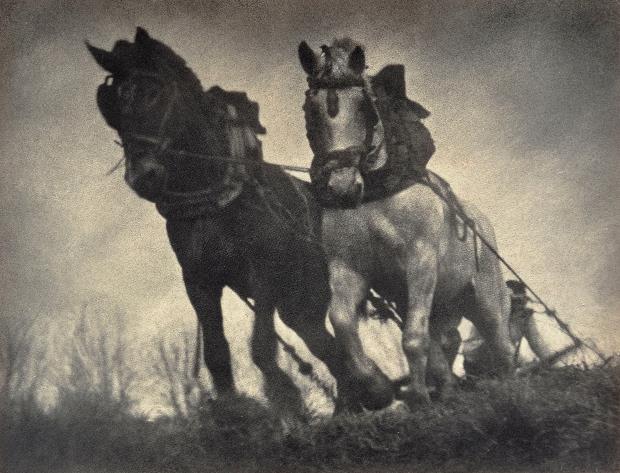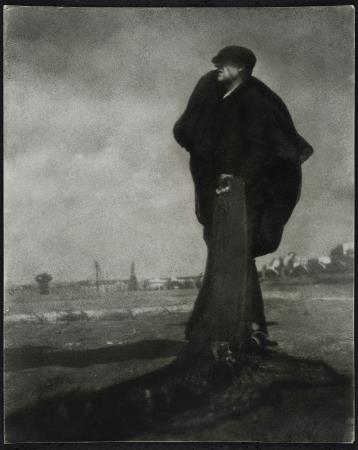Roser Cambray

Sometimes the reverse side of a photograph, that is to say, the back of the work, can give us a lot of information about where it came from and where it has been. This entry on the museum blog is based on an enigmatic image, taken in the small town of Kalispell (Montana, USA) where gentlemen with their backs to us, in 1936, are looking at some photographs in a daze and serve as an excuse for us to delve into some of the works that Antoni Campañà’s family deposited in the Museu Nacional d’Art de Catalunya in 2020.
It all starts with a photograph: Horsepower

In 1999, the Generalitat de Catalunya acquired a unique photograph by Antoni Campañà that until 2020 had been conserved in the photographic collection of the museum. The work was Horsepower from 1933, one of the artist’s most award-winning photographs and one that he was most proud of. It was published in the magazine Art de la Llum in March and April of 1934 and was the winner, along with three others from the Bromoil Process, of the X Contest of the Photographic Association of Catalonia. A unique photograph that, despite its dramatic force, its importance in the author’s career and the recognition it had at the time, can be said to have been isolated within the photographic collection.
The deposit by the Campañà i Capella family
In 2018, the museum team began working on the study of Campañà’s work, especially the photographs from the period of pictorialism, which ended up becoming a generous deposit of 63 photographs by the family in 2020. This new addition to the collection allows us to delve into the work of the author and places the museum as an essential place for the study of the photographs of Antoni Campañà.
Campañà had started out in photography from a very young age and quickly learned that this would be his profession. Very soon, specifically in 1927, he became associated with the Agrupació Fotogràfica de Catalunya (The Photographic Association of Catalonia) where he met some of the photographers who would be teachers and friends and with whom he would share his passion for photography. These first works are part of the movement of pictorialism, which emerged around 1888 and became strongly rooted in Catalonia until the middle of the 20th century. This movement proposed the use of pigment techniques that evoked the manual work of painting and fine arts, as well as symbolic or picturesque themes.

It can be said that Antoni Campañà, especially after a trip to Germany in 1933, went a step further and combined this legacy of pigmentation techniques, such as bromoil or the bromoil transfer, in which he excelled, with a new vision that looked towards the new European aesthetic currents. Thus, in his work we find a hybrid between pictorialist techniques and a new language close to the currents of the Neues Sehen or the New objectivity, such as, for example, the use of diagonals, dynamic points of view with high and low angles and more daring frames. That is to say, a new way of taking photographs where classic elements are mixed with a more modern aesthetic.
Within these works, which date from the 1930s to the 1950s, we can see some of the author’s most iconic pieces during these years, as well as some of the lesser-known ones, which had not been published or exhibited before.


Antoni Campañà. Tractor, 1931. Deposit by the Campañà Capella family, 2020; Antoni Campañà. More Sheaves, 1936. Deposit by the Campañà Capella family, 2020
With a restless and curious spirit, in his work we often find a search for the subject of country trades and farmers, the sea and the fishermen and the arrival of the train in the city, looking for a contrast between the rural world and the urban world. At the same time, we can also see a passion for photography itself, for example in the work, Hobby which was chosen for the cover of the magazine American Photography of March 1934.



Antoni Campañà, Untitled (Caldes de Boí), 1929. Deposit by the Campañà Capella family, 2020; Antoni Campañà Walking, 1936. Deposit by the Campañà Capella family, 2020; Antoni Campañà, Hobby ,1933. Deposit by the Campañà Capella family, 2020
We can also find a series of photomontages from the 1930s, produced for advertising photography with a complex balance of multiple perspectives, which give the works a great modernity. If we take a close look at Untitled (All types of transportation. Photomontage), we see in it a reiteration of Horsepower in contrast with the modernity of the lorries.


Antoni Campañà Untitled (All types of transport. Photomontage), around 1930-1936. Deposit by the Campañà Capella family, 2020; Antoni Campañà Untitled (The railway train. Photomontage), around 1930-1936. Deposit by the Campañà Capella family, 2020
The discovery in 2018 of the red boxes with the Civil War photography that Campañà had hidden, what we knew about the way this artist took photographs suddenly changes. If before 1936 he had enjoyed handling photographs and working on their negatives and prints almost ad infinitum, with the advent of the Civil War, there wasn’t time to process everything and he needed immediacy. The technological changes made the cameras more manageable and allowed for greater autonomy when taking photos. However, Campañà would choose some of the photographs from this period and enlarge them in the form of bromoil or bromoil transfer. Inside the repository of the Campañà i Capella family, we can find several examples of works on the subject of the civil war that the author sent to photo salons and competitions around the world, such as the works The militiaman or Rifleman [Vicente Burón] in which the author portrayed two militiamen in a heroic way.



Antoni Campañà. The Militiaman, 1936. Deposit by the Campañà Capella family, 2020; Antoni Campañà. Rifleman [Vicente Burón], 1936. Deposit by the Campañà Capella family, 2020; Antoni Campañà. Untitled [Moroccan soldiers of the African Army], 1939. Deposit by the Campañà Capella family, 2020
The salons
Pictorialism was the first discourse of artistic legitimation which was properly photographic and its main dissemination was done above all through exhibitions, both national and international. Among the enthusiasts, the fact of having a work accepted in a salon gave them prestige and meant the recognition of the photographic sector. Participation in salons everywhere was marked on the back of the work with the labels of the places where it had taken place.
In issue number nine of the magazine Galeria, the international magazine of artistic photography in October 1935, in the section dedicated to the Spanish contribution to foreign salons, you can read: “The publication, the American Annual of Photography, patiently publishes statistics every year of the contribution of different countries to the main Salons of the World, a statistic that in 1934 comprised 71 Salons. Of the 45 countries listed in it, Spain ranks ninth in terms of the number of exhibitors […] we can see that the well-known artist Antonio Campañà breaks the record.” Indeed, if we look at the number of works by Spanish authors, we can see that between 1929 and 1934, Campañà appears in 114 salons, being the author with more works presented in the foreign salons.
Inside the repository we also find two cards full of labels of salons and competitions from around the world that belong to the works, Rifleman [Vicente Burón] and Francesc Nel·lo painting the anti-fascist train of the Draughtsmen’s Union. The latter presents such a profusion of labels in the form of glued papers, that there are some of them that are almost superimposed on each other. As we approach it, we find labels from 1937 and 1938 from photographic groups and societies across the United States. Specifically twenty-four labels of: The Boston Camera Club (Massachusetts), The Canton Photographic Society (Ohio), Binghamton Camera Club Museum of Art (New York), Crystal City Camera Club (Virginia), The Charleston Camera Club (Virginia), Photo Art Print Gallery (San Francisco),The Olean Miniature Camera Club (New York),Lansing Camera Club (Michigan), Camera Club of Richmond (Virginia), Rome Camera Club (New York), The Westchester Camera Club (Indiana), Tasopé Camera Club -The Aurora School of Photo-Engraving, Aurora (Missouri), Bluefield Pictorial Society (Virginia), Photographic Guild of Philadelphia (Pennsylvania), Delaware County Camera Club(Delaware), Malone Camera Club(New York), The Hocking Valley Camera Club (Ohio), Ithaca Camera Club (New York), Bridgeport Amateur Camera Club (Connecticut), Oak Park Camera Club(Illinois), Tulsa Camera Club (Oklahoma), La Porte Camera Club (Indiana), Westfield Camera Club(New York) and the Kalispell Camera Club (Montana).
Let’s resolve the mystery



Antoni Campañà. Francesc Nel·lo painting the anti-fascist train of the Draughtmen’s Union, 1936. Deposit by the Campañà Capella family, 2020; Cartolina del revers de l’obra Francesc Nel·lo painting the anti-fascist train of the Draughtmen’s Union, 1936. Deposit by the Campañà Capella family, 2020: Detail of the image stuck on the back of the work Francesc Nel·lo painting the anti-fascist train of the Draughtmen’s Union.
If we get a little closer to the label of the Kalispell Camera Club of Montana, we solve the riddle of the mysterious photograph with which we started this blog. So the back of Francesc Nel·lo’s photograph from the Campañà repository hid a treasure, a small vintage photograph where enthusiasts look at photographs of a salon in the town of Kalispell. Among the enthusiasts, we can see adults, young people and children, and if we look closely at the photographs one by one, we discover the work of the Francesc Nel·lo painting the anti-fascist train of the 1936 Draughtsmen’s Union, hanging on the wall. A surprise that required it almost to be observed in an enlarged way, but that tells us how a photograph taken in Catalonia in the thirties could travel around the world returning to the hands of its author, Antoni Campañà, to end up being shown again in the retrospective exhibition “The Endless War. Antoni Campañà 1906-1989. The tensions of a gaze” which can be seen until 18th July at the Museu Nacional d’Art de Catalunya.
We encourage you to discover the rest of the photos from this repository on the website of the museum.
Related links
The Endless War. Antoni Campañà
Antoni Campañà. The tensions in a gaze (1906-1989) [Online Exhibition]
Fotografia







